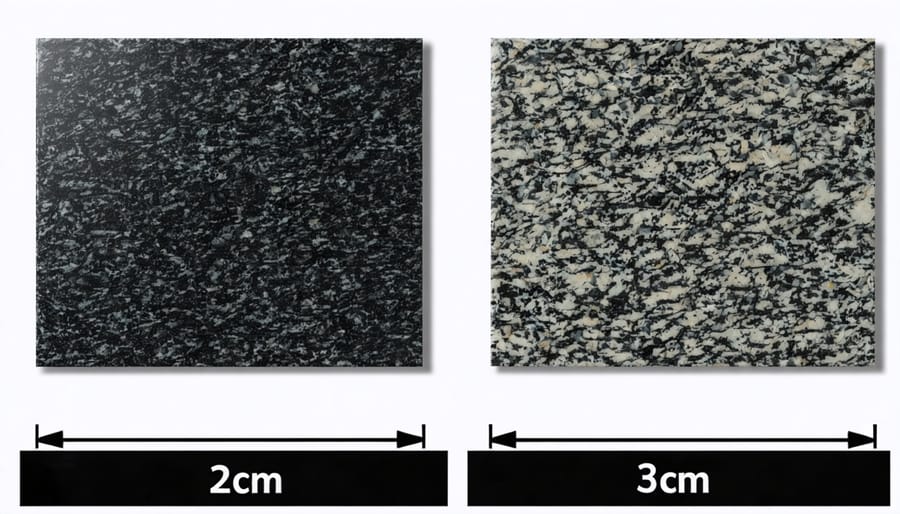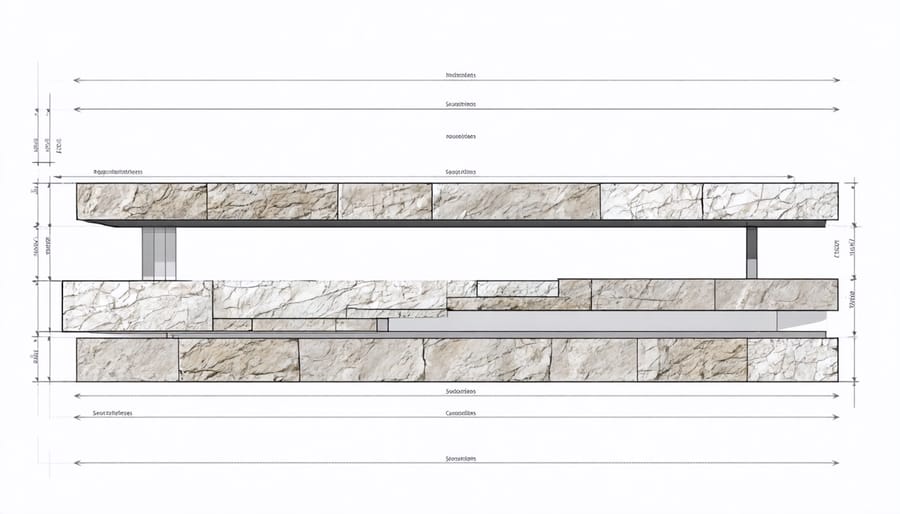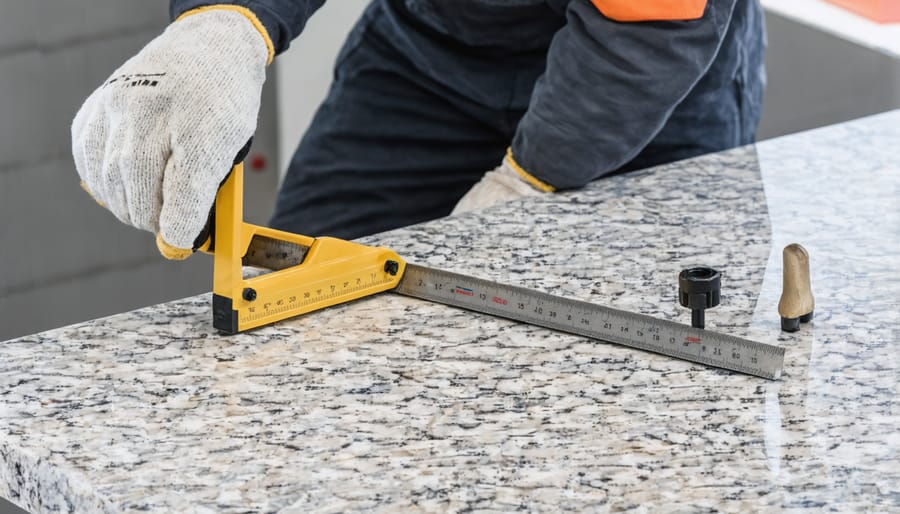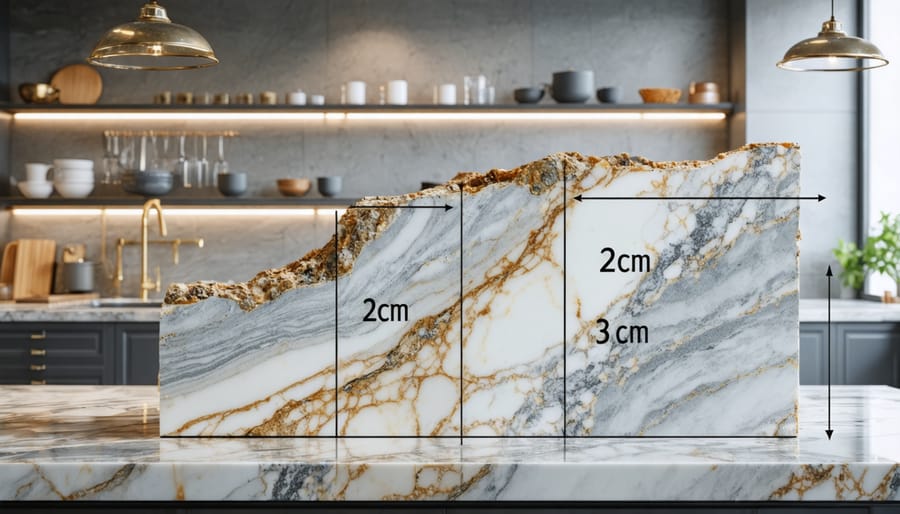When it comes to granite countertops, thickness stands as one of the most crucial yet frequently overlooked specifications that determines both performance and aesthetics. The industry standard for granite countertop thickness typically ranges from 2-3 centimeters (approximately 3/4 to 1-1/4 inches), with 3cm emerging as the preferred choice for modern installations. This standardization isn’t arbitrary – it represents decades of experience in balancing durability, weight constraints, and installation requirements across millions of kitchen installations worldwide.
Understanding granite thickness specifications is essential whether you’re planning a new kitchen installation or evaluating an existing countertop’s quality. The right thickness not only ensures structural integrity but also impacts everything from edge profile options to overall cost. While thinner slabs might seem economical initially, they often require additional support and may limit design possibilities, making the standard 3cm thickness a optimal choice for most residential applications.
Standard Granite Countertop Thickness Explained
Common Thickness Options
In the granite countertop market, two primary thickness options dominate: 2cm (approximately ¾ inch) and 3cm (approximately 1¼ inch). The 3cm thickness has become the industry standard in North America, accounting for roughly 75% of residential installations. This preference stems from its superior structural stability and refined aesthetic appeal.
The 2cm option remains popular in certain applications, particularly in vertical installations like backsplashes and wall cladding. It’s also commonly used in commercial settings where weight considerations are important, such as high-rise buildings. While 2cm granite requires additional support through plywood subtops or laminated edges, it offers cost savings on material and can be easier to transport and install.
Both thicknesses provide excellent durability and longevity when properly installed. The choice often depends on factors such as cabinet construction, overall design aesthetic, and budget considerations. Professional fabricators typically recommend 3cm for horizontal surfaces like kitchen countertops, while 2cm might be suggested for less demanding applications or when working with existing cabinetry designed for thinner tops.

Regional Variations
While 3cm (1.18 inches) is widely accepted as the standard granite countertop thickness in North America, regional variations do exist across different markets. In Europe, for instance, 2cm (0.78 inches) thick granite countertops are more common, particularly in countries like Italy and Spain. This thinner profile is often preferred for its modern aesthetic and lighter weight.
Asian markets, particularly in countries like China and India, commonly use both 2cm and 3cm thicknesses, with some manufacturers offering custom specifications to meet local preferences. In Australia and New Zealand, 3cm remains the predominant standard, though there’s a growing trend toward thinner profiles in contemporary designs.
Manufacturer preferences also influence regional standards. Some fabricators specialize in specific thickness ranges based on their equipment capabilities and local market demands. Large-scale producers often maintain consistent thickness standards across regions to optimize production efficiency, while smaller local fabricators might offer more flexibility in customization.
It’s worth noting that these regional variations typically don’t affect the countertop’s durability when proper installation methods are used.
How Thickness Affects Performance
Structural Integrity
The structural integrity of granite countertops directly relates to their thickness and proper support requirements. A standard 3cm (1.25-inch) granite slab can typically support its own weight across a span of up to 24 inches without additional reinforcement. However, any overhang exceeding 10 inches should be supported with corbels or brackets to prevent potential stress cracks or sagging.
For kitchen islands and longer spans, support requirements become even more critical. Cabinets must be completely level and structurally sound to properly distribute the substantial weight of granite, which can range from 18 to 20 pounds per square foot. A plywood subtop of at least 5/8-inch thickness is recommended to provide uniform support across the entire surface.
Areas around sinks and cooktops require particular attention, as these cutouts can weaken the overall structure. Professional installers typically reinforce these zones with steel rods or fiber mesh embedded in epoxy along the underside of the granite. For thinner 2cm (3/4-inch) granite installations, a full plywood underlayment is mandatory, and shorter spans between supports are necessary to maintain structural stability.
Regular inspection of support structures and immediate attention to any signs of stress can help ensure your granite countertop maintains its structural integrity for decades.

Installation Considerations
When planning to install granite countertops, thickness plays a crucial role in determining the installation requirements. Standard 3cm (1.25-inch) granite typically requires minimal additional support beyond properly spaced cabinet bases and brackets at overhangs. However, spans exceeding 24 inches may need additional reinforcement to prevent potential stress cracks.
For 2cm (¾-inch) granite installations, a plywood substrate is mandatory to provide adequate support and prevent flexing. This substrate should be at least ¾-inch thick and properly secured to the cabinet framework. Edge treatments for thinner granite may also require additional reinforcement to achieve the desired appearance.
Installation considerations should account for weight differences between thicknesses. A 3cm slab weighs approximately 19 pounds per square foot, while 2cm weighs about 13 pounds. This affects the number of installers needed and may influence cabinet structural requirements.
Seam placement becomes more critical with thinner slabs, requiring careful planning to ensure stability. Support brackets for overhangs must be sized appropriately: 3cm granite typically allows for 10-inch unsupported overhangs, while 2cm requires support at 6 inches or less.
Cost Implications of Different Thicknesses
The thickness of your granite countertop significantly impacts the overall granite countertop costs and long-term value of your investment. Typically, 3cm (1¼ inch) thick granite slabs cost 20-30% more than their 2cm (¾ inch) counterparts due to increased material volume and handling requirements.
For a standard kitchen with 40 square feet of countertop space, choosing 3cm thickness might add $400-600 to your project compared to 2cm options. However, this initial cost difference often balances out when considering installation expenses. Thinner 2cm slabs require additional support and usually need plywood underlayment, which increases labor and material costs.
The long-term value proposition also favors thicker slabs. Three-centimeter granite offers superior durability and requires less structural support, potentially reducing maintenance costs over time. It’s particularly cost-effective for larger installations or areas with extended overhangs, as it eliminates the need for additional reinforcement.
Commercial applications often find better value in 3cm thickness despite higher upfront costs, as it provides better resistance to heavy use and reduces the likelihood of cracks or breaks that would require costly replacements. However, for smaller residential projects or vertical applications like backsplashes, 2cm thickness can offer excellent value while maintaining structural integrity.
When calculating your budget, consider that premium granite varieties will show a more pronounced price difference between thicknesses compared to standard grades, sometimes reaching up to 40% variation in material costs alone.
Making the Right Choice for Your Project
Application-Specific Recommendations
For kitchen countertops, the standard 3cm (1.25″) thickness is ideal as it provides excellent durability for daily food preparation and can support undermount sinks without additional support. This thickness also allows for elegant edge profiles and withstands the weight of heavy appliances commonly found in kitchens.
In bathroom applications, both 2cm (0.75″) and 3cm thicknesses work well, though 2cm is often preferred for vanity tops due to its lighter weight and lower cost. When using 2cm granite in bathrooms, ensure proper support underneath, especially around sink cutouts.
Commercial settings typically demand 3cm thickness due to higher traffic and usage demands. This is particularly important for restaurant counters, hotel reception desks, and retail displays where durability is paramount. For commercial bar tops, 3cm thickness is essential to accommodate overhang requirements without additional bracing.
For outdoor kitchen installations, always opt for 3cm thickness to ensure maximum stability and weather resistance. The thicker material better withstands temperature fluctuations and environmental stress while providing adequate support for outdoor kitchen equipment.

Professional Assessment Tips
When consulting with fabricators and installers about your granite countertops, ask detailed questions about their thickness measurement process. Request to see samples of their standard 3cm (1¼ inch) and 2cm (¾ inch) options to understand the visual and structural differences. A reputable fabricator should explain their support requirements for different thicknesses and discuss any specific challenges your layout might present.
During assessment, ensure the fabricator examines your cabinet structure and discusses appropriate support methods. For large overhangs or spans, ask about additional reinforcement options like corbels or steel brackets. Quality professionals will provide written documentation of their recommended thickness based on your specific installation requirements.
Request information about their quality control processes, including how they verify consistent thickness across slabs and their methods for ensuring proper support during installation. Discuss their warranty coverage and what it includes regarding thickness-related issues. Also, ask about their experience with similar projects and if they can provide references from past clients with similar installations.
Remember to get all thickness specifications and support requirements in writing as part of your project documentation.
Understanding standard granite countertop thickness is crucial for successful kitchen and bathroom projects. The industry standard of 3cm (1.25 inches) provides an optimal balance of durability and practicality for most residential applications, while 2cm (0.75 inches) remains a viable option when properly supported. Remember that thicker slabs offer enhanced durability and fewer support requirements but come at a higher cost.
When planning your countertop installation, consider your specific needs, budget, and intended use. For high-traffic areas or spaces where you want a more substantial appearance, 3cm thickness is recommended. If cost is a primary concern and proper support can be implemented, 2cm thickness may be suitable.
Always work with reputable fabricators who can guide you through material selection and ensure proper installation techniques. Regular maintenance and care will help preserve your granite countertop’s beauty and functionality, regardless of thickness. By understanding these thickness standards and their implications, you can make an informed decision that balances aesthetics, durability, and cost-effectiveness for your specific project requirements.










